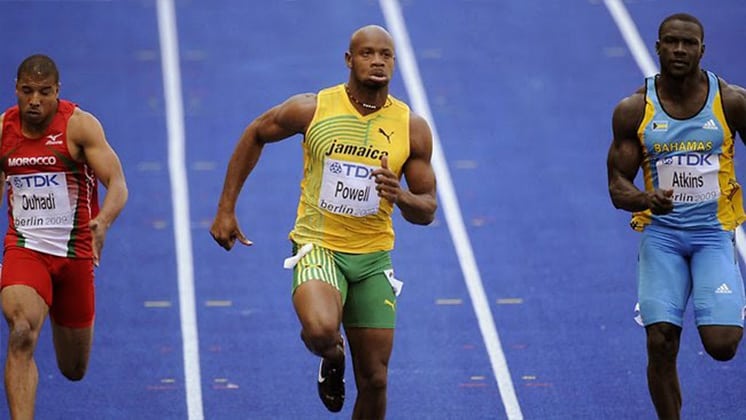
When it comes to building a lean and muscular physique there’s no doubt that strength training is a necessity. But, what about cardio?
We all know that cardio is positive to our health and that we should do it for that reason. We also know that cardio can help us burn more fat and allow us to stay lean easier.
But what about our gains? Will cardio reduce our ability to build strength and muscle?
There’s a lot of question marks around combining strength and cardio. In this post I’m going to cover the benefits of implementing cardio to your lifting regimen, sort out exactly what happens when combining strength training with cardio, and also finish the article off with a sample week of combined strength and cardio sessions.
Let’s go.
Table of Contents
Benefits of Doing Cardio
Before looking at whether or not it’s possible to combine strength and cardio training and still see great results, let’s first look at the benefits of doing cardio.
1. Cardio Helps You Burn Fat
Even though cardio doesn’t burn fat in and of itself (for that to happen you must be in a calorie deficit), it can however help you burn more calories making it easier to lose body fat if that’s your goal. Or help you stay lean easier if your goal is bulking to build lean muscle.
No matter your goal, by doing a few cardio sessions per week you can increase your energy expenditure.
Furthermore, a potential benefit of cardio is improved calorie partitioning. Calorie partitioning has to do with where calories “go” in the body when you eat.
It’s been shown that the most potent calorie partitioning tool we have is training. Where regular low intensity cardio activity increases nutrient uptake in our muscles, instead of the nutrients getting stored in our fat cells.
This is still in debate, and research isn’t completely sure about the effects of nutrient partitioning yet. However, it certainly won’t hurt to do some low-to moderate intensity cardio in reasonable amounts, as this may help you build more muscle and put on less fat during a long lean-bulk phase for example.
Lastly, another huge benefit of doing cardio during a bulking phase is that it’ll make it easier for you to lose fat in the future.
Here’s the thing:
If your goal is to build a lean and muscular physique quickly and effectively, then adding some fat during your bulking phases just comes with the territory, as this will maximize your muscle growth.
And adding fat to your frame means that, eventually you’ll have to diet the fat off, ideally at around 15 % body fat for males. This is also the reason why I recommend utilizing bulking and cutting cycles. Anyways, doing cardio when bulking helps a lot with the transition from bulking to cutting. And here’s Lyle McDonald’s explanation of why:
 “During the overfeeding that is needed to generate maximum gains in muscle mass, the body often loses some of its ability to use fat as a fuel and this can take a couple of weeks to get fully ramped back up when calories are restricted (I suspect this explains some of the odd delay that seems to occur in true fat loss when people start dieting again).
“During the overfeeding that is needed to generate maximum gains in muscle mass, the body often loses some of its ability to use fat as a fuel and this can take a couple of weeks to get fully ramped back up when calories are restricted (I suspect this explains some of the odd delay that seems to occur in true fat loss when people start dieting again).
And this seems to be even more pronounced if folks have been doing zero cardio while they are gaining muscle mass. By keeping in some amount of cardio during the mass gaining phase, at least some ability to use fat effectively for fuel is maintained. When the dieting phase eventually starts, the body will be in a better place to use fat for fuel.”
2. Improves Recovery Slightly
We have two types of recovery: active recovery and passive recovery. The right kind of cardio can work as a sort of active recovery.
If you are sore from your lifting, doing some light cardio may help reduce your DOMS (Delayed Onset Muscle Soreness) and this is usually an indicator of improved recovery.
The way cardio helps with recovery is by increasing blood flow to the trained muscles. When you increase blood flow, you improve oxygen and nutrient delivery to the trained muscles from the air you breathe and the food you eat.
Now, this effect might not be the biggest, research isn’t completely certain on this topic either. What we do know is that you certainly don’t need to do cardio to get recovered from your workouts, but it can help.
3. Cardio Builds Work Capacity & Conditioning
It’s not uncommon that people who only lift weights lose a lot of their work capacity and metabolic conditioning. Lower repetition and long rest interval type training have the greatest impact on reducing conditioning and work capacity.
But n ow you might ask:
So, I lose some work capacity and conditioning, but is that really important if all I want is to be lean, muscular and strong?
Well, actually it is. Keeping at least a baseline of work capacity and conditioning is important as it will help you recover better both during a training session and in-between sessions.
The good thing is that it takes very little cardio training to maintain baseline conditioning, a lot less than what it does to develop it in the first place. So keeping at least some cardio in your training program goes a long way when it comes to keeping baseline work capacity.
4. Imroves Cardiovascular Health
Cardio when is important for the same reason that it always is, because of health!
It improves the flow of oxygen throughout your body, lowers your blood pressure and cholesterol, and reduce your risk for heart disease, diabetes, Alzheimer’s disease, stroke, and some kinds of cancer.
Not only will adding some cardio in your strength training routine promote greater health, it’s also been shown that low intensity cardio reduces stress and thus promotes a healthier environment in the body.
This environment also promotes better recovery, which can lead to both better muscle growth and fat loss.
5. Cardio Makes You Feel More Energized
This is something I think is connected to the health aspect of doing cardio.
In the beginning of my fitness journey I didn’t do any cardio, except for the occasional power walk or bike ride outside. All I did was watching my diet and strength trained. Even though this approach worked, as you can see in my transformation video, one thing I learned recently was that I lacked a lot of daily energy back then.
Here’s how I learned that:
When I began PT school 6 months ago, I started doing cardio twice per week with my class. And this had me feel A TON more energized.
I feel more productive and alert during the days, and best of all my sleep quality went up immensely. This is a very positive benefit, since sleep is one of the most important factors when it comes to improving ones physique.
Why Strength Trainees Fear Cardio
For years people who have seeked to build a lean and muscular physique have avoided cardio like the plague, fearing it will cause muscle loss and reduced strength. And for understandable reasons as well, since the earliest research on combined cardio and weight training did show negative effects on muscle growth and strength adaptations.
Where one paper from Hickson back in 1980 showed that high frequency, high volume combined training did not provide the same positive adaptations as strength training alone would.
And this was supported by a 1999 paper from Leveritt et al which stated that combined strength and endurance training appears to inhibit strength and muscle development when compared with strength training alone.
In addition to this, a 2005 study showed that doing additional cardio or combined training decreased the anabolic response from resistance training.
Now, these studies were published a few decades ago and had several limitations. And since then there have been newer studies conducted showing that this might not be the whole story. So let’s fast forward a few decades!
We now have several studies showing that adding in cardio in your lifting regimen might actually not be that detrimental to gains in strength and muscle mass as previously thought.
Recent research has shown that when programmed sensibly and correctly, cardio + weight training can boost strength and even support muscle growth!
In a 2012 study they put this to the test, utilizing a 21 week combined program on beginners. Where participants were split into 3 groups, performing either:
- Cardio training only;
- Strength training only; or
- Cardio + strength training
After 21 weeks, they found no difference in power output between the strength training only group and the combined group. Interestingly, the combined group improved muscle mass by the greatest amount compared to strength or cardio only (11% vs 6% vs 2%).
Now a good question to ask is if this study was just an anomaly?
Well the answer is, actually no. Another research trial tested the effects of biking post leg resistance training. In this study, they also found that the combined training group improved peak power and strength by a similar amount to the strength training only group.
And for muscle growth, just like in the previously mentioned study they saw the greatest improvement in the combined group, finding a 14% improvement vs only 9% in the normal strength group.
Finally, in this study they tested the biological responses within the cell, trying to highlight if there are any limitations from combined training from a physiological or cellular perspective. What was found was that combined training did not impact the main biological pathway behind muscle growth, known as muscle protein synthesis.
Additionally, they looked at specific muscle fiber changes, which is the most accurate way to track muscle growth, finding a whopping 300% greater improvement for the combined group.
Why The Difference Between Earlier and Recent Research?
Now, how come the results from the earlier studies all showed negative results of combined training on hypertrophy and strength, while the more recent ones show positive results, especially for muscle growth?
Well, it all has to do with the programming.
Based on all of the literature, any potential negatives of combined training tend to occur when subjects either overtrain, do strength and cardio in the same session and/or uses high impact cardio modalities.
For example, the earlier trials of combined training were having participants performing several sessions of both cardio and strength training throughout a training week, which could amount up to a total of 10 workouts per week! Which is likely too much training volume for the body to be able to recover from.
In fact, considering these subjects were likely young college students, with poor lifestyle, diet and sleep patterns, it’s not surprising that the combined group became overtrained and had drops in performance.
In the more recent studies, the approach have been more intelligent when it comes to setting up the training volume and frequency, where in most studies the participants did “only” around 4-5 workouts per week in total. Which is a more sensible amount of work that are easier to recover from, meaning that gains in strength, hypertrophy and endurance can actually be achieved simultaneously.
Why You Should Ideally Spread Out Your Cardio And Weight Lifting
It’s been shown that doing strength training and cardio in the same session seems to be suboptimal for gains.
This was shown in a study by Robineau et al where they looked at whether sprinting after full body intense workouts with a recovery time of 0, 6, or 24 hours between strength and aerobic sequences influences the responses to a combined training program.
The group doing their sprint intervals directly after strength training gained less strength than the other three groups, but there were no differences in strength gains between the strength-only group and the two groups resting at least six hours between their strength training and their sprint intervals.
So, resting at least 6 hours between sessions seems to be optimal for strength adaptations if doing concurrent training.
Also, a recent meta-analysis from 2017 by Murlasits et al showed that, if you need to do cardio on the same day, then doing it after lifting is better for strength improvements compared to doing it before. On the other hand though improvement of aerobic capacity seems to not be affected by training order.
Last but not least, the type of endurance training that are being used seems to significantly affect the magnitude of gains in strength and hypertrophy.
In fact, in the more recent studies just mentioned, where the participants increased muscle mass in the legs by 11% in the first study, 14 % in the second study and showed an improvement of 300 % for specific muscle fiber changes in the third study all with concurrent training, the type of endurance training used was cycling performed on a bike. (Show cycling on a bike)
A meta-analysis of 21 studies done by Wilson et al showed that resistance training concurrently with running, but not cycling, resulted in significant decrements in both hypertrophy and strength.
This seems to be because running is much more disruptive of the muscular system with a movement that is also very nonspecific to strength training. During running there’s such a large eccentric portion, where every step causes eccentric shocks that are known to cause a lot of muscle damage.
With running the stress on the legs would simply be too large, making recovery harder, which would ultimately result in decreased performance and muscle mass.
While contrarily, cycling has nearly no eccentric portion at all, meaning less total stress, while it is also more similar to a squat or leg press movement.
This means that cycling done in combination with resistance training adds just enough training volume so that the body can still recover, while also doing so through a longer range of motion that is very specific to squatting or leg pressing.
What’s also worth mentioning is that, if for some reason you are not seeking to add a lot of muscle mass to your legs, but seeking to really build your upper body, then running might still be a viable option, since it mainly stresses your legs.
However, this would only be viable as long as the total amount of volume from doing running in combination with upper body training don’t get too high so that you can’t recover on a full body systemic level.
Now, there’s actually no need to do additional concurrent training on the bike in order to eek out additional gains, because you could just do additional volume with your strength training instead. With that said though, doing cardio can be very beneficial.
Practical Takeaways: Combining Strength and Cardio Training
Okay, so the practical takeaways are as follows:
Implementing a bit of cardio in your lifting regimen is healthy and seems to have further benefits on both muscle growth and fat loss, simply making it easier to build an aesthetic looking lean and muscular physique.
However, when combining strength and cardio training you must pay attention to your recovery, levels of fatigue, and strength in the gym. If you notice a decline or plateau in performance then reducing your cardio either by time or by a session or two will most likely do the trick.
Also, to minimize the interference effect, separating strength training and cardio with at least six hours is preferable.
And finally, using low impact cardio, such as cycling seems like the best choice, since it’s been shown to actually improve muscle growth as long as it’s programmed diligently.
High impact cardio, such as running on the other hand seems to reduce muscle growth, especially in the legs that gets too eccentrically overloaded. If you don’t care about leg development so much, then running is still fine in moderation.
Okay, so let’s look at a couple of good sample combined training routines:
Sample #1: 4 Day Strength 2 Day Cardio Routine
Monday: Lower-body Weight Training
Tuesday: Upper-body Weight Training
Wednesday: Cardio Training
Thursday: Upper-body Weight Training
Friday: Lower-body Weight Training
Saturday: Cardio Training
Sunday: Rest
This is a typical upper/lower split which is supported by science as being one of the best frequencies to train with for maximizing full body muscle growth.
And since cardio training most often uses the legs, the training routine is laid up in such a way that cardio is separated from leg training with the most time possible.
Sample #2: 3 Day Strength 2 Day Cardio Routine
Monday: Upper-body Weight Training
Tuesday: Cardio Training
Wednesday: Lower-body Weight Training
Thursday: Rest
Friday: Upper-body Weight Training
Saturday: Cardio Training
Sunday: Rest
This is a 3 day per week upper/lower split with just 1 leg workout. This is much easier to recover from than the 4 day upper/lower split above, and should be used if you’re looking to get the most bang for your buck. It’s also a great routine to use when cutting, since your recovery capacity is reduced when in a calorie deficit.
What Type of Cardio to do
When it comes to cardio there are generally three different types people refer to:
- Low intensity steady state (LISS)
- Moderate intensity steady state (MISS)
- High intensity interval training (HIIT)
I’m sure you’ve heard that doing moderate intensity steady state (MISS) is negative when it comes to muscle growth and strength development, and that Low intensity steady state (LISS) and High intensity interval training (HIIT) is fine.
Well, this isn’t entirely true. The reason why people believe this is because it’s so easy to do too much training when you do MISS. It’s not a problem with the training modality, it’s a problem with doing too much training volume, so recovery becomes an issue, which can lead to strength plateaus.
This means that it’s completely fine to pick any of the modalities as long as you’re not training too much. So, let’s look at what too much is:
How To Program Your Cardio
Let’s walk through each of the cardio modalities one by one:
1. Low Intensity Steady State Cardio

This type of cardio is the easiest kind and is a very effective active recovery tool, but it requires more time to give noticeable effects on health and calorie burn.
Low intensity cardio is only suppose to raise your heart rate a bit, for most people low intensity would happen somewhere between a brisk walk or a slow jog. You should be able to keep a conversation going without much effort.
How Much LISS to do:
- 7000-10000 steps walking or jogging slowly, or the equivalent on another modality, per day is a good guideline for health and calorie burn.
- LISS is so low impact that it won’t interfere with strength training even if you do a lot of it. Some powerlifting and olympic weightlifting teams use this type of cardio daily for active recovery.
What Type of Modality to Choose When Doing LISS?
- Any modality such as walking, jogging, cycling, rowing and swimming etc. is okay.
- I think that “lifestyle cardio” is the best cardio that you can do. This would be for example, taking brisk walks/light joggs or the bike to your work, gym or the store. Doing this gives you a lot of additional daily movement without you having to think about it too much. Leave the car home 😉
2. Medium Intensity Steady State Cardio

This is the type of cardio that you should be very careful with, since it’s easy to go overboard on the amount of total training volume you do in a week.
MISS is when you do some sort of cardio activity repeatedly at a moderate intensity. As opposed to LISS, this is when it’s hard to keep a conversation, you’re sweating, and your heart rate is elevated to moderate or high levels.
This is the main type of cardio training that marathon runners do to get a lot of distance under their belt. Unfortunately for our goals, this training also promotes the body of a marathon runner as well.
How Much MISS to do:
- Keep sessions short and don’t do more than 2 hours of this cardio per week.
- MISS will interfere with strength training if you do too much of it.
- Do MISS for the purpose of burning calories, not for improving performance, as trying to improve performance will interfere with your strength training.
What Type of Modality to Choose When Doing MISS?
- Any modality except jogging and running.
- Jogging and running is much more disruptive of the muscular system with a movement that is also very nonspecific to strength training. During running there’s a large eccentric portion which are known to cause a lot of muscle damage. When running the stress on the legs would simply be too large, making recovery harder, which would ultimately result in decreased strength training performance and muscle mass.
- If your goal is to mainly build your upper body, then running is okay.
3. High Intensity Interval Training
 This type of cardio is great.
This type of cardio is great.
It’s awesome for conditioning, burns more calories per minute compared to low intensity cardio and it’s also been shown to support strength and muscle gains because it’s very similar to weightlifting in terms of high effort and rest periods.
However, you shouldn’t do too much of this cardio either, since it’s very taxing on recovery, which could “steal” recovery from your strength training. It’s much better to allow most of your recovery to be spent on the type of training that will give you the most gains, i.e lifting weights.
How Much HIIT to do:
- 15 minutes 2-3 times per week.
- HIIT can help promote strength and muscle growth if done moderately. But it can interfere with strength training if you do too much of it.
What Type of Modality to Choose When Doing HIIT?
- Any modality except jogging and running.
- Jogging and running is much more disruptive of the muscular system with a movement that is also very nonspecific to strength training. During running there’s a large eccentric portion which are known to cause a lot of muscle damage. When running the stress on the legs would simply be too large, making recovery harder, which would ultimately result in decreased strength training performance and muscle mass.
- If your goal is to mainly build your upper body, then running is okay.
Here’s a Good HIIT Routine:
- 3-5 minute warm-up
- 30 seconds all out
- Rest 30 seconds (complete rest or moving slowly)
- 30 seconds all out
- Rest 30 seconds
- Repeat this for 15 minutes
Instead of doing HIIT routines like the one above, you could play sports 1-2 times per week on rest days for 20-30 minutes. Sports usually involve short periods of high intensity efforts with periods of walking or resting, so it’s very similar to HIIT.
A great benefit of playing sports is that they’re typically more enjoyable than normal “cardio” because you do something that’s not as repetitive, and you can have fun playing with your friends or a team in the meanwhile.
What’s Next?
As you’ve learned in this post, cardio is mostly a tool to bump up calorie expenditure to easier achieve a lean and muscular looking physique. It’s also a great addition to any training regimen for it’s health benefits.
Now, when it comes to actually building an aesthetic looking physique what’s most important is that you get your strength training and diet set up correctly accordingly to your starting point and goal physique. To learn this I recommend reading the guide: How to Build an Aesthetic Physique by clicking here!

I get that HIIT is primarily categorized as cardio, but I don’t get why it can’t be a method of combining strength and cardio training. I’ve been thinking about restarting PIIT 28, bc it’s fun. Warm up followed by 28 minutes of HIIT, alternating 7 cardio and strength training moves (each day targeting a different muscle group) at 45 seconds on 15 seconds off, 4 rounds with 30 seconds between rounds. Core focused routine after, then flex training. If I can work through the muscle fatigue and my energy levels throughout the day are ok, is there any benefit to separating cardio and strength?
I think that combining strength and cardio training can be effective at increasing muscle growth. A lot of people do this with concepts like High intensity interval bodybuilding and high intensity functional bodybuilding etc. The problem with these kind of approaches is that they’re less effective ways to build muscle than what training more specifically for muscle growth using strength training with long rest in between sets. The reason for this is that you activate more endurance cellular pathways (ampk etc.) in your muscles which can hinder growth. This is also why the sessions should be separated for maximum gains.
With that said though, if you believe it to be fun, as I do myself from time to time, then I see no problem using these kind of training concepts other than the slightly less gains in muscle mass. You will have better cardio though!